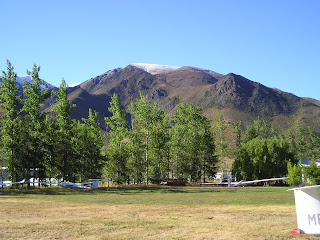Gliding
Hawkes Bay - Sunday 12th July 2020
The gliding forecast for Sunday 12th
July was for improving, but “average” wave lift from early afternoon. Here in
Hawkes Bay, wave lift is normally caused by westerly
winds from the Tasman Sea reaching the ranges that run down the centre of the
North Island. With suitable conditions, the wind lifts over the ranges and then
comes down the other side and “bounces” off the ground and repeats this
movement causing a “standing wave” much like large waves in a river flowing
over the rocks. Clouds often form along the lines of lift with higher level
wave shown by “lenticulars.” Depending on conditions, there can be multiple
lines of wave that weaken further from the mountains but can continue well out
over the sea as can be seen in the satellite photo below which was taken on 18th
April 2020.
Satellite photo 18th April 2020
Wave systems
contain areas of lift (which is often silky smooth), areas of sink and
turbulent rotor as in the diagram below.
Pilots in
Hawkes Bay have climbed to over 33,000ft in wave.
With the sky
starting to match the forecast by early afternoon, Jason and Brian Kelly
launched from seal runway 019 in their ASH25M motor glider and reached a line
of wave at about 1,500ft just west of the airfield. This was “blue wave” as it
had no cloud marking it. It was also broken (not continuous lift in lines) and
weak (up to 5kts / 500 feet per minute climbs) so they continued west into the
next wave line. This had a few cloud scraps marking it and was also broken and
changing rapidly but stronger in places. After shutting the engine down and
retracting it, they utilised the lift to climb to almost 8,500ft before diving
west to the next line.
The next wave
line was well marked to the south and much stronger. Climbs of over 13kts /
1,300ft per minute were recorded as they headed south. As oxygen was not being
used, they limited their height to 9,500ft and turned around once the cloud
started to block their progress which was south of Flemington.
Tracking
north, stacked lenticulars were visible over Te Mata Peak.
Closer to home
were great views of Hastings and Napier.
Having to land
and be back in the hangar before dark, the glider then headed back to land at
Hastings Airfield into a blustery SW. So after the use of around 5 litres of
petrol and just over two hours of flying, the flight was completed. More than 200km
had been flown at altitudes of up to 9,500ft feet and the flight was in what
glider pilots would call “very average wave”. As a comparison, the world record
is now over 3,000km for a glider wave flight (in South America) and the New
Zealand record is over 2,500km, including a double crossing of Cook Strait.
To learn more about wave, the “air pockets”
and other sources of lift and sink you fly through in powered aircraft, come
and visit the gliding club for a soaring flight. As members of the aeroclub,
you are entitled to fly with the gliding club at gliding club rates for a trial
flight - this is just the cost of the launch which is typically around $70 -
$80 for a 2,000ft launch. For youth members, we currently have funding
available from an Eastern & Central Community Trust grant which allows us
to offer free gliding club member subscriptions and half price tow fees of just
$4 per minute for those youth members who want to learn to glide.
While soaring flights are weather dependent,
once you have experienced one, you will want to join us. Further details about
the club and learning to glide are on the gliding club website at http://www.glidinghbw.co.nz/



















































.jpg)